Got a pain in your tailbone that just won’t go away? Well, that kind of discomfort can turn even the simplest tasks into a real challenge. Whether it’s from an old injury, too much sitting, or a mystery cause, a sore tailbone can seriously slow you down. But don’t worry, relief is closer than you think. In this blog, we’re diving into the fastest ways to heal a sore tailbone, with easy exercises and stretches that anyone can do.
From gentle moves that ease the pain to strength-building exercises that provide long-term support, we’ve got you covered. Plus, we’ll share some posture tips and sitting adjustments to help you stay comfortable and prevent future pain. Ready to find some relief and get moving again? Let’s get started!
Contents
What Causes Tailbone Pain, Although I Have No Injury?
 Wondering why your tailbone hurts even though you haven’t injured it? Tailbone pain, or coccydynia, can pop up without a clear injury for several reasons. Here are some common causes:
Wondering why your tailbone hurts even though you haven’t injured it? Tailbone pain, or coccydynia, can pop up without a clear injury for several reasons. Here are some common causes:
- Spending too much time sitting, especially on hard or uncomfortable surfaces, can put extra pressure on your tailbone, leading to pain.
- Slouching or maintaining a poor posture while sitting can also stress your tailbone
- Sudden weight gain or loss can affect the cushioning around your tailbone.
- As you get older, the discs that cushion the bones in your spine, including your tailbone, can wear down, leading to pain.
- Activities that put repeated stress on your tailbone, like cycling or rowing, can irritate the area even without a single, clear injury.
- For women, childbirth can sometimes cause tailbone pain, as the tailbone moves and flexes to allow the baby to pass through the birth canal, leading to potential stress or injury.
If you’re dealing with tailbone pain and can’t trace it back to a specific injury, these factors might be contributing to your discomfort.
How To Quickly Heal From Sore Tailbone
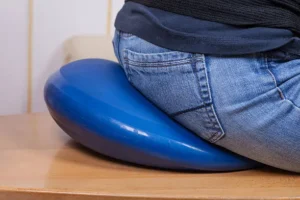 When tailbone pain strikes, finding quick relief is a top priority. Here are several effective ways to ease the discomfort right at home:
When tailbone pain strikes, finding quick relief is a top priority. Here are several effective ways to ease the discomfort right at home:
- Use a Tailbone Cushion: A cushion with a cut-out design at the back can relieve pressure on your tailbone when you sit.
- Apply Heat Therapy: Use a heating pad or a warm towel and apply it to the area for 15-20 minutes several times a day.
- Try Ice Therapy: For acute pain or after a recent injury, applying an ice pack wrapped in a cloth to the tailbone area can reduce inflammation and numb the discomfort. Use for 15-20 minutes at a time, several times a day, but not directly on the skin.
- Gentle Stretching: Perform stretches that target the lower back and pelvic area to relieve tension and reduce pain. Simple stretches, like those that we will outline further, can be very beneficial.
- Avoid Sitting for Long Periods: When possible, stand or walk around to reduce continuous pressure on your tailbone. If you must sit, alternate sitting positions and take frequent breaks to stand or walk.
- Try non-steroidal anti-inflammatory drugs (NSAIDs) like ibuprofen, which can help reduce pain and inflammation.
- Adjust Your Sleeping Position: Sleeping on your side with a pillow between your knees can help alleviate pressure on the tailbone.
If you’re a back sleeper, try placing a pillow under your knees to maintain the natural curve of your spine.
Implementing these strategies can offer quick relief from sore tailbone pain and help make your recovery period more comfortable.
Gentle Stretches to Heal Sore Tailbone
Relieving tailbone pain can be as simple as doing a few easy stretches. Here are some gentle stretches you can try anywhere, no special equipment needed:
Pelvic Tilt
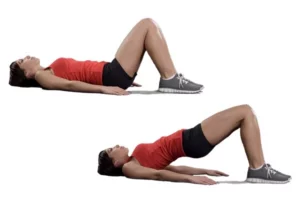
- Lie on your back with knees bent and feet flat on the floor.
- Tighten your stomach and push your lower back into the floor.
- Hold for 5 seconds, then relax. Repeat 10 times.
Knee Hugs
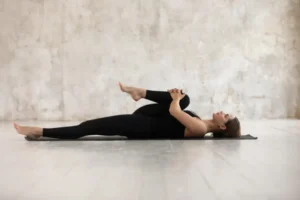
- Still lying on your back, slowly bring one knee up to your chest.
- Hold it with both hands and pull gently towards your chest.
- Hold for 20-30 seconds, then switch legs. Do it 3 times for each leg.
Seated Forward Bend

- Sit on the floor with your legs stretched out in front of you.
- Slowly bend forward at the hips, reaching towards your toes.
- Hold for 20-30 seconds, then sit back up. Repeat 2-3 times.
Piriformis Stretch
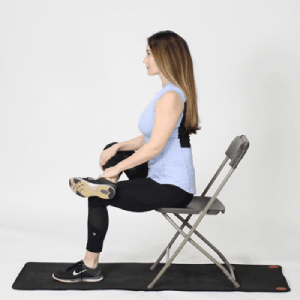
- Sit on a chair and cross one leg over the other so that your ankle rests on the opposite knee.
- Gently lean forward, keeping your back straight.
- Hold for 20-30 seconds, then switch legs.
Cat-Cow Stretch
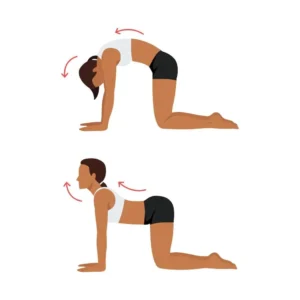
- Start on your hands and knees in a tabletop position.
- As you inhale, arch your back down, lifting your head and tailbone towards the ceiling (Cow).
- As you exhale, round your back up, tucking your chin to your chest and pulling your tailbone under (Cat).
- Move smoothly between these positions for 1-2 minutes.
These stretches can help relieve pressure on your tailbone and reduce pain. Remember to stretch gently and hold each stretch to the point of a mild pull, never to pain.
Strengthening Exercises for Tailbone Support
Strengthening the muscles around your tailbone can provide better support and help reduce pain. Here are some low-impact exercises that are gentle on the tailbone but effective in building strength:
Pigeon Pose Stretch

- Start by being on all fours in a tabletop position on a yoga mat.
- Bring your right knee forward and place it behind your right wrist, while angling your right foot towards the left.
- Slowly extend your left leg back, keeping it straight, and lower your hips towards the floor.
- Square your hips towards the front of your mat. Depending on your flexibility, you can keep your torso upright to intensify the stretch in your hips or lean forward over your bent knee to deepen the stretch.
- Hold the position for 20-30 seconds, breathing deeply to relax into the stretch.
- Carefully release from the pose and switch legs to repeat the stretch on the other side.
Bridge

- Lie on your back with knees bent and feet flat on the ground, arms by your sides.
- Lift your hips towards the ceiling, forming a straight line from your shoulders to your knees.
- Hold for 10-15 seconds, then slowly lower back down. Repeat 10 times.
Bird-Dog

- Start on your hands and knees, with your wrists under your shoulders and knees under your hips.
- Extend one arm forward and the opposite leg back, keeping your back flat and core engaged.
- Hold for a few seconds, then switch to the other arm and leg. Do 10 repetitions on each side.
Wall Squats
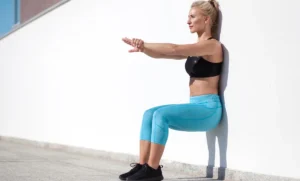
- Stand with your back against a wall, feet shoulder-width apart.
- Slide down the wall into a squat position, keeping your back flat against the wall.
- Hold for 20-30 seconds, then slide back up. Repeat 5-10 times.
Clamshells
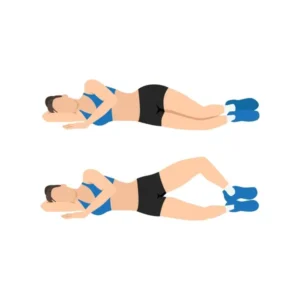
- Lie on your side with hips and knees bent, feet together.
- Keeping your feet together, open your top knee as far as you can, then close it.
- Do 10-15 repetitions, then switch sides.
These exercises target the pelvic floor, glutes, and lower back muscles, offering more stability and support to the tailbone area. Remember to move slowly and stop any exercise that increases your pain.
Treatment for Chronic Tailbone Pain
 Chronic tailbone pain, or persistent coccydynia, can be particularly challenging to live with, but there are various treatments available to help manage the pain and improve your quality of life. Here’s what you can do:
Chronic tailbone pain, or persistent coccydynia, can be particularly challenging to live with, but there are various treatments available to help manage the pain and improve your quality of life. Here’s what you can do:
- Physical Therapy: Working with a physical therapist can be incredibly beneficial. They can teach you specific exercises to strengthen the muscles around the tailbone, improve posture, and relieve pressure on the coccyx.
- Manual Manipulation: Some healthcare providers specialize in manual manipulation techniques that can help realign the coccyx if it’s misaligned and relieve tension in the muscles and ligaments around the tailbone.
- Injections: In cases where pain is severe, your doctor might recommend injections. Corticosteroid injections can reduce inflammation in the area, while nerve block injections can help manage pain by blocking pain signals from the tailbone to the brain.
- Medications: Apart from over-the-counter pain relievers, your doctor might prescribe stronger painkillers or antidepressants that can also help relieve chronic pain.
- Surgery: As a last resort, if other treatments don’t relieve the pain, surgery to remove the coccyx (coccygectomy) may be considered. This option is rare and typically only recommended after extensive evaluation.
It’s important to always consult with healthcare professionals to determine the most appropriate treatment options for your specific situation.
Need Professional Help? Visit Us Today!
Dealing with a sore tailbone can feel like a long journey, but you don’t have to go through it alone. Whether your pain is new or something you’ve been trying to manage for a while, professional help can make a big difference in your recovery. Physical therapy is a powerful tool in helping patients recover from all kinds of pain, including the discomfort associated with tailbone issues.
If you’re experiencing back pain, shoulder pain, knee pain, neck pain, elbow pain, hip pain, or are struggling with arthritis, our physical therapists at MantraCare and PhysioMantra are here to support you.
Don’t let pain hold you back any longer. Whether you prefer the convenience of online physical therapy sessions with PhysioMantra or the comprehensive care at MantraCare, we’re ready to help you on your path to recovery. Book your physiotherapy session today and take the first step towards a pain-free life.


